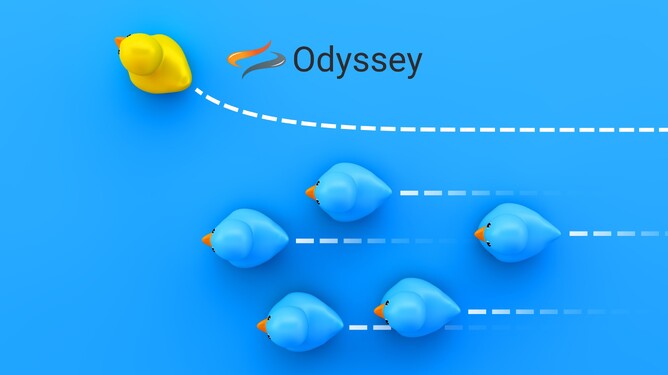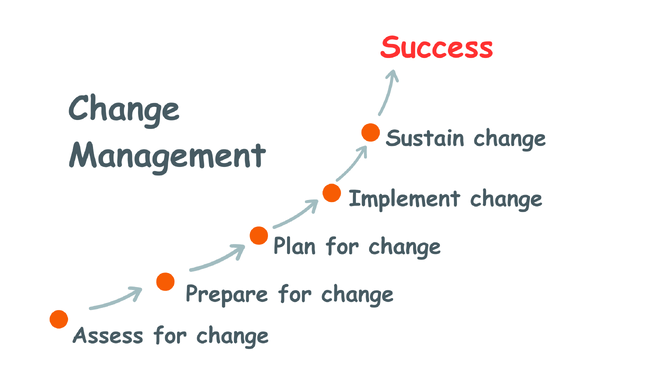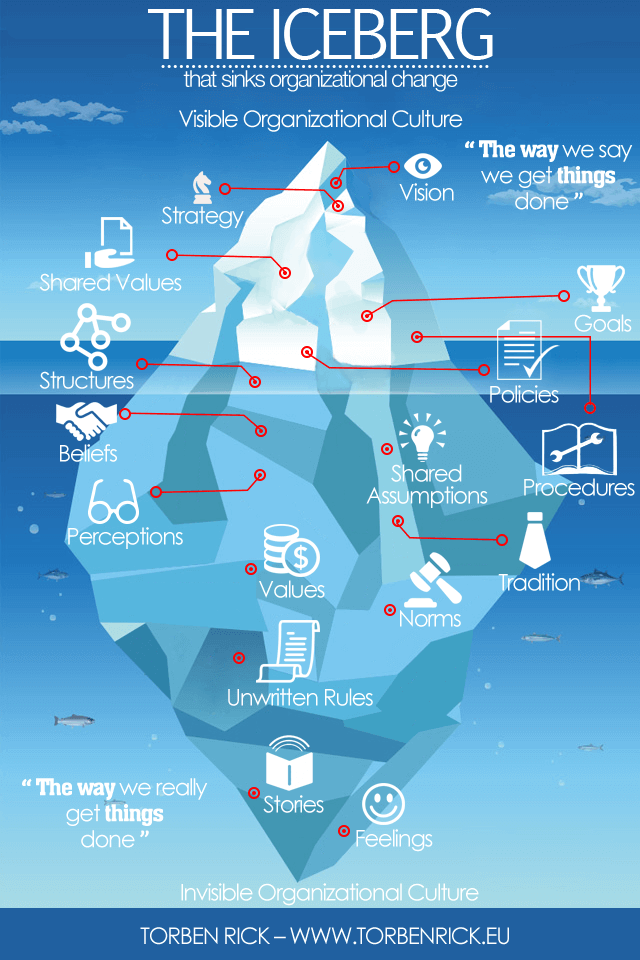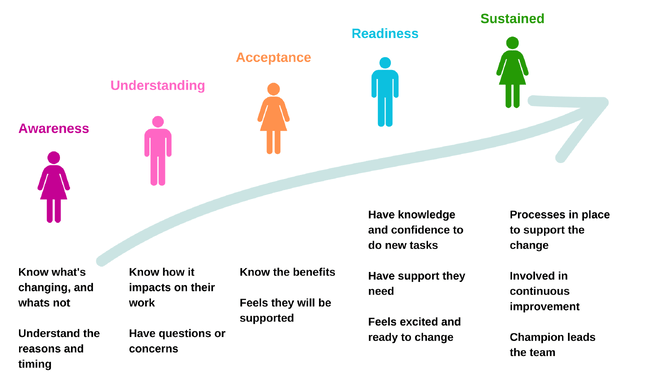People + Process + the right Tools = Success
Successfully implementing change like 'fit for purpose' management software can be divided into three stages. Applying these can reduce resistance to change, and increase the likelihood of success.
Each stage must consider the People and the Process and of course the 'Tools'
1. Foundation - Plan and Prepare
2. Communicate and Engage
3. Implementation
1. Foundation - Plan & Prepare
It's good to start by asking WHY when planning something. This sets the foundation for everyone to know the reasons for change.
· Why change - what do you want to achieve?
· How will this change occur – what solution have you chosen?
· When is the best time to undertake this change – during the off ‘tourism’ season?
· How and when will this be communicated with staff and stakeholders?
· Who will be involved?
· How to build resilience in your staff and organisation?
Prepare a road map
This should include...
· Planning out the communication touch points, key tasks and milestones and when they need to occur.
· How and when will the change be implemented – software can take time to onboard so disruption to the business needs to be minimised.
· What project tasks are required eg when to transition from existing systems eg data migration
· What training, coaching or support will people need? What training services does the software provider have available?
· Set times and stages to ‘check in’ on achieving the milestones
Prepare to build resilience - Adaption is critical
An Organisation's Culture has a significant influence on the outcomes of Change Management... how adaptive is your company's culture, or is it fixed?
'It is not the strongest species that survive, nor the most intelligent,
but the ones who are most responsive to change' - Charles Darwin
It’s important that all people understand how the company's culture (vision, values, goals, process and practices, and attitudes) align with the need & decision for change.
For example, implementing management software will touch many parts of the business, from achieving the vision or goals of the business, to finance, reservations, operations and outwards to the customer and your providers.
If your team knows why this change occurs and who and what it impacts, then they are more likely to accept change, to the point where they own it. Equally, explaining the consequences of not making the change can also be valuable.
The Hidden Culture
Take your time reading this section...
Like this iceberg example there are many hidden cultural and behavioural 'ways' that your staff, team leaders, and other stakeholders will carry with them into a change process.
The lens they look through comes from their values, beliefs, assumptions, feelings and perceptions. So it's critical to communicate, listen and enquire into these as a group, but also with individuals. Not considering these ‘hidden cultures’ can lead to individuals or groups playing a significant role in disrupting or disengaging with the actions and outcomes you are trying to seek with the change process. We all have our own personal icebergs in a work environment, as well as ones we have built with our colleagues... your job is to bring these to the surface.
Being open and honest about what these are and how these cultures play a role in how the business operates and performs can lead to barriers being removed and individual and team drive and willingness to pursue new cultures... and ultimately embracing the change.
2. Communicate and Engage
Why do we needs to do this?
The first critical step to communicating is to explain the reason for change to staff, the board, or other stakeholders. And to listen to their questions or concerns.
Putting your people at the centre of why we have made this decision will help them understand the reasons why.
These might include...
· Outgrowing spreadsheets or doc’s – someone else to look after the calculations?
· Automate manual tasks – no more copy and paste, duplication and errors?
· Consolidate multi systems into one – remove the silos between systems
· Improve quality customer experiences – improve your business NPS?
· Competitive advantage – Repeat, Refer, Review
· Invest in business system and process improvement – increase productivity and profit
· Build an intangible asset for the business – increase the value of the business
Listen to your staff
What concerns do people have about this change?
Adoption is a journey
What impact will this have on people?
· What’s going to be different, and stay the same?
· What role will your staff play – which people are supporters of the change?
· What are some barriers that could get in the way?
· What does success look like – what’s the end result?
· What journey do I need to take my staff on – see this change adoption curve to understand where your staff are at.
Identify a Champion
A champion is someone who will take a leading and important role during the change management process. They will be someone who is passionate and supportive of the change, and who is able to support others through change, be a good communicator and able to handle any concerns or objections. They will be a key and influential role between the business and the software provider. They could be responsible for ...
· Building support amongst staff and stakeholders
· Identifying areas of resistance
· Enjoying staff have the resources and support they need
· Participate or undertake in training new features
· Recognising and celebrating the successes
3. Implementation
A lot depends on the type of change being undertaking as to how implementation occurs. There’s some common questions or observations we’ve made that are specific for end to end management system change like Odyssey provides. Once again planning for supporting people and the project are at the top of the list.
Do you need an onboarding plan?
It’s important you have an onboarding plan – this will set out the timeline, tasks that the provider will undertake, and tasks you and your team need to undertake. Part of of working with your Odyssey account manager is to establish an onboarding plan that’s set up specific for your business needs, available resources and your timeframes.
Do you choose to invest in on site training?
Management software platforms like Odyssey are comprehensive, as is your business which will likely have lots of moving parts, different services that need to align. For example between Sales, Reservations and Operations. Having expert training for staff from the software provider onsite can make a big difference to the learning phase, teaching the champion and getting staff competent and confident. At Odyssey, we understand staff have different learning styles and so we can tailor this with different training options for your team.
Taking on more than you can handle
It’s important to know that with a comprehensive management solution like Odyssey that you don’t need to have all things in place, and staff competant on day 1. Odyssey is designed to be implemented at your pace, so that might mean getting the core product in place and functioning first, then adding modules at another stage. This means you and your team are not pressured to do all things at the same time.
Learning about your business practices or processes during this change.
It’s quite common that changing management systems can lead to re-evaluating how the business operates. For example product pricing & packages, customer service processes and standards, and operational delivery are areas of your business where you might seek to change practice on.
How can you motivate, support and transition people during this change?
· Put in place a software ‘champion’ to support staff and link to the software provider.
· Setting aside some time to learn, share and coach as a group as you role out the stages of implementation can be valuable.
· Understand where each of your staff is at along the change adoption curve will help to know what support they require.
How well are you progressing
What metrics can you measure to show you have addressed the problem.
This relates to the specific goals you're trying to achieve by making the change. Go back to the reasons why you’re changing and set up some measures for these... more time, more profit, less errors, reducing costs etc
How do you continue to ensure the outcomes are sustained?
Once software is set up, and staff are trained and competent the next phase is really about maintaining this. Inducting new staff into your organisation requires careful transitioning, but preparing a good introduction to the software and supporting them through the induction period is valuable here.
Celebrate the Successes
No matter how small they might seem to you, they may be significant for your staff.
Our Onboarding Commitment
At Odyssey we mentor you through the Onboarding Process to ensure the best outcomes for your team. In addition we have comprehensive help manuals and support options available.






